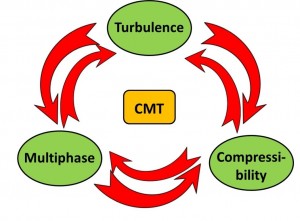The US Department of Energy (DOE) National Nuclear Security Administration (NNSA) Office of Advanced Simulation and Computing (ASC), in collaboration with Lawrence Livermore National Laboratory (LLNL), Los Alamos National Laboratory (LANL) and Sandia National Laboratories (SNL), are initiating the next phase of the academic computational science program, called Predictive Science Academic Alliance Program II (PSAAP II). The vision for PSAAP II consists of participation by leading U.S. universities focusing on three major integrated areas:
- Predictive Science based on verification and validation and uncertainty quantification (V&V/UQ) for large-scale simulations;
- Discipline-focused research needed to further predictive science and enabled by effective Exascale computing ; and
- Developing and demonstrating technologies and methodologies to support effective Exascale computing in the context of science/engineering applications.
Center for Compressible Multiphase Turbulence (CCMT) is one of the six new PSAAP-II centers of excellence whose primary focus will be on the emerging field of predictive science The intellectual objectives of the proposed work are threefold:
- To radically advance the field of compressible multiphase turbulence (CMT) through rigorous physics-based understanding;
- To advance very large-scale predictive simulation science on present and near-future platforms; and
- To advance a co-design strategy that combines exascale emulation with a novel energy-efficient numerical approach.
The center will perform petascale, and work towards exascale simulations of instabilities, turbulence and mixing in particulate-laden flows under conditions of extreme pressure and temperature to investigate fundamental problems of interest to national technological leadership. Verification of codes and validation of the physical models are substantially harder for CMT. The center will engage in vigorous verification, validation, uncertainty reduction and uncertainty propagation activities in the context of CMT. The center will develop novel techniques for accurate characterization of probability tails in the uncertainty quantification of rare but critical events. The center will leverage the unique Novo-G facility at UF to develop an unprecedented capability to behaviorally prototype in hardware a variety of promising next-generation exascale architectures for CMT application. This center is funded for five years.

